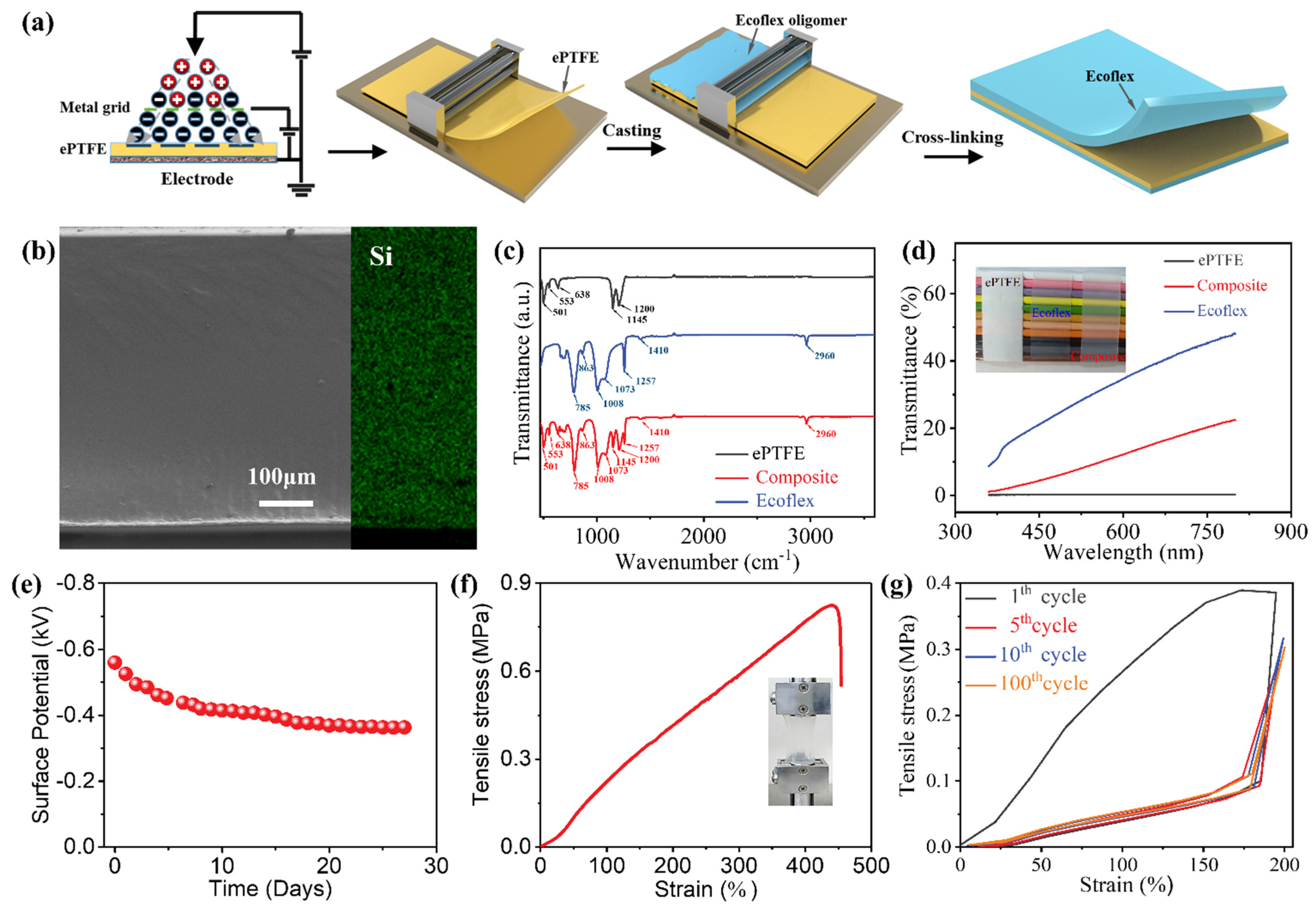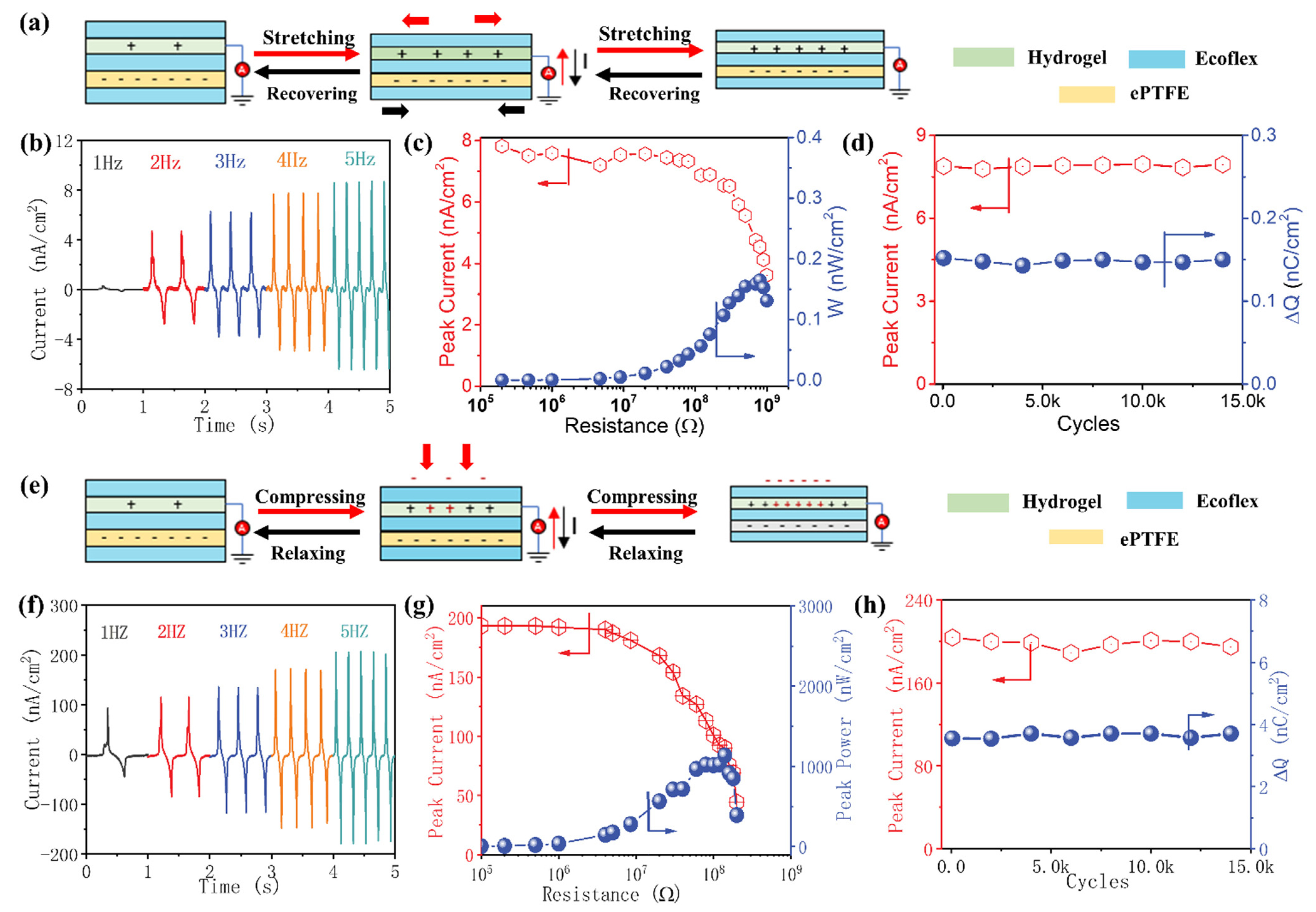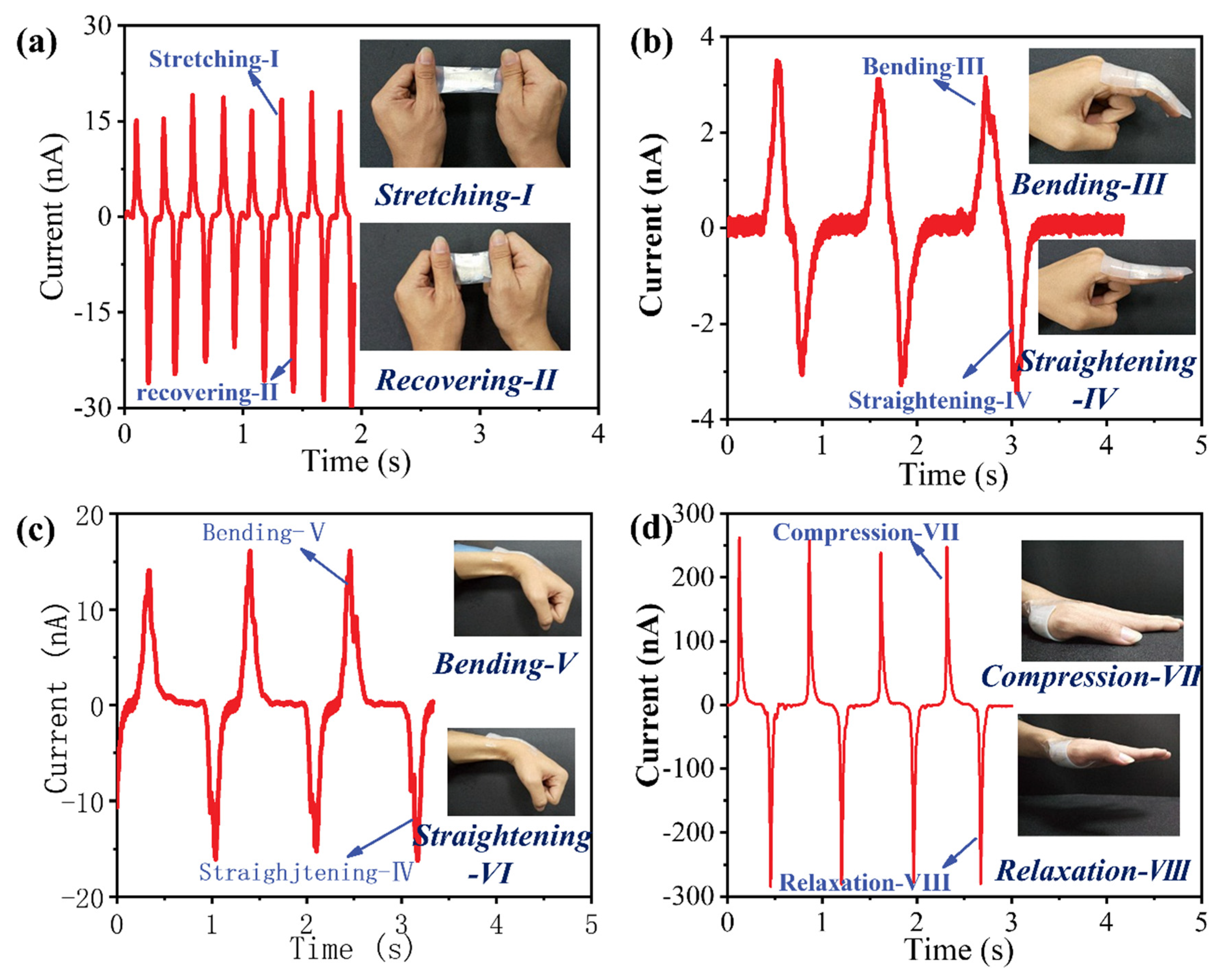A Stretchable Expanded Polytetrafluorethylene-Silicone Elastomer Composite Electret for Wearable Sensor
Abstract
:1. Introduction
2. Experimental Section
3. Results and Discussion
4. Conclusions
Supplementary Materials
Author Contributions
Funding
Informed Consent Statement
Conflicts of Interest
References
- Hu, Y.; Shi, Y.; Cao, X.; Liu, Y.; Guo, S.; Shen, J. Enhanced output and wearable performances of triboelectric nanogenerator based on ePTFE microporous membranes for motion monitoring. Nano Energy 2021, 86, 106103. [Google Scholar] [CrossRef]
- Ma, X.; Zhang, X. In Vibration energy harvesting with stretchable electrets. In Proceedings of the 2018 IEEE 2nd International Conference on Dielectrics (ICD), Budapest, Hungary, 1–5 July 2018; pp. 1–4. [Google Scholar]
- Xia, Z.; Ma, S.; Qiu, X.; Wu, Y.; Wang, F. Influence of porosity on the stability of charge and piezoelectricity for porous polytetrafluoroethylene film electrets. J. Electrostat. 2003, 59, 57–69. [Google Scholar] [CrossRef]
- Xie, J.; Wang, Y.; Dong, R.; Tao, K. Wearable Device Oriented Flexible and Stretchable Energy Harvester Based on Embedded Liquid-Metal Electrodes and FEP Electret Film. Sensors 2020, 20, 458. [Google Scholar] [CrossRef] [PubMed] [Green Version]
- Ko, Y.S.; Nüesch, F.A.; Opris, D.M. Charge generation by ultra-stretchable elastomeric electrets. J. Mater. Chem. C 2017, 5, 1826–1835. [Google Scholar] [CrossRef]
- Guo, Z.; Patil, Y.; Shinohara, A.; Nagura, K.; Yoshida, M.; Nakanishi, T. Organic molecular and polymeric electrets toward soft electronics. Mo. Syst. Des. Eng. 2022, 7, 537–552. [Google Scholar] [CrossRef]
- Xu, Z.; Bao, K.; Di, K.; Chen, H.; Tan, J.; Xie, X.; Shao, Y.; Cai, J.; Lin, S.; Cheng, T.; et al. High-Performance Dielectric Elastomer Nanogenerator for Efficient Energy Harvesting and Sensing via Alternative Current Method. Adv. Sci. 2022, 18, 2201098. [Google Scholar] [CrossRef]
- Kho, T.C.; Baker-Finch, S.C.; McIntosh, K.R. The study of thermal silicon dioxide electrets formed by corona discharge and rapid-thermal annealing. J. Appl. Phys. 2011, 109, 053108. [Google Scholar] [CrossRef] [Green Version]
- Zhang, S.; Wang, Y.; Yao, X.; Le Floch, P.; Yang, X.; Liu, J.; Suo, Z. Stretchable Electrets: Nanoparticle–Elastomer Composites. Nano Lett. 2020, 20, 4580–4587. [Google Scholar] [CrossRef]
- Kilic, A.; Shim, E.; Yeom, B.Y.; Pourdeyhimi, B. Improving electret properties of PP filaments with barium titanate. J. Electrostat. 2013, 71, 41–47. [Google Scholar] [CrossRef]
- He, W.; Guo, Y.; Zhao, Y.-B.; Jiang, F.; Schmitt, J.; Yue, Y.; Liu, J.; Cao, J.; Wang, J. Self-supporting smart air filters based on PZT/PVDF electrospun nanofiber composite membrane. Chem. Eng. J. 2021, 423, 130247. [Google Scholar] [CrossRef]
- Schröder, S.; Strunskus, T.; Rehders, S.; Gleason, K.K.; Faupel, F. Tunable polytetrafluoroethylene electret films with extraordinary charge stability synthesized by initiated chemical vapor deposition for organic electronics applications. Sci. Rep. 2019, 9, 2237. [Google Scholar] [CrossRef] [PubMed] [Green Version]
- Yuan, D.; Wan, L.; Zhang, H.; Jiang, J.; Liu, B.; Li, Y.; Su, Z.; Zhai, J. An Internal-Electrostatic-Field-Boosted Self-Powered Ultraviolet Photodetector. Nanomaterials 2022, 12, 3200. [Google Scholar] [CrossRef] [PubMed]
- Wang, J.; Rychkov, D.; Gerhard, R. Space–Charge electret properties of polypropylene films with transcrystalline or spherulitic structures—A comparison of functionalities at interfaces. J. Appl. Phys. 2021, 129, 064101. [Google Scholar] [CrossRef]
- Li, Y.; Yin, X.; Si, Y.; Yu, J.; Ding, B. All-Polymer hybrid electret fibers for high-efficiency and low-resistance filter media. Chem. Eng. J. 2020, 398, 125626. [Google Scholar] [CrossRef]
- Li, X.; Wang, Y.R.; Xu, M.X.; Shi, Y.Q.; Wang, H.M.; Yang, X.; Ying, H.T.; Zhang, Q. Polymer electrets and their applications. J. Appl. Polym. Sci. 2021, 138, 50406. [Google Scholar] [CrossRef]
- Shinohara, A.; Yoshida, M.; Pan, C.; Nakanishi, T. Stretchable π-conjugated polymer electrets for mechanoelectric generators. Polym. J. 2022, 1–7. [Google Scholar] [CrossRef]
- Zhang, S.W.; Shao, S.B.; Yang, X.X.; Chen, P.J.; Ji, H.; Liu, K.Y.; Wu, T.H.; Shen, S.P.; Xu, M.L. An enhanced flexoelectric dielectric elastomer actuator with stretchable electret. Smart Mater. Struct. 2021, 30, 9. [Google Scholar] [CrossRef]
- Deng, Q.; Liu, L.; Sharma, P. Electrets in soft materials: Nonlinearity, size effects, and giant electromechanical coupling. Phys. Rev. E 2014, 90, 012603. [Google Scholar] [CrossRef] [Green Version]
- Anton, S.; Farinholt, K.; Erturk, A. Piezoelectret foam–based vibration energy harvesting. J. Intell. Mater. Syst. Struct. 2014, 25, 1681–1692. [Google Scholar] [CrossRef]
- Wegener, M.; Wirges, W.; Tiersch, B. Porous polytetrafluoroethylene (PTFE) electret films: Porosity and time dependent charging behavior of the free surface. J. Porous Mater. 2007, 14, 111–118. [Google Scholar] [CrossRef]
- Hu, H. Smart polydimethylsiloxane sponges with high piezoelectric responses. Polym. Eng. Sci. 2022, 62, 3964–3972. [Google Scholar] [CrossRef]
- Ghosh, A.; Yoshida, M.; Suemori, K.; Isago, H.; Kobayashi, N.; Mizutani, Y.; Kurashige, Y.; Kawamura, I.; Nirei, M.; Yamamuro, O.; et al. Soft chromophore featured liquid porphyrins and their utilization toward liquid electret applications. Nat. Commun. 2019, 10, 4210. [Google Scholar] [CrossRef] [PubMed] [Green Version]
- Yuk, H.; Zhang, T.; Lin, S.; Parada, G.A.; Zhao, X. Tough bonding of hydrogels to diverse non-porous surfaces. Nat. Mater. 2016, 15, 190–196. [Google Scholar] [CrossRef] [PubMed] [Green Version]
- Małecki, J.A. Linear decay of charge in electrets. Phys. Rev. B 1999, 59, 9954–9960. [Google Scholar] [CrossRef]
- Ma, X.; Yang, X.; Ding, C.; Zhang, X.; Dai, Y.; He, P. Theoretical analysis and experimental validation of frequency-moldable electrostatic energy harvesters biased with a high elastic electret film. Smart Mater. Struct. 2021, 30, 065021. [Google Scholar] [CrossRef]
- Tao, X.; Zhou, Y.; Qi, K.; Guo, C.; Dai, Y.; He, J.; Dai, Z. Wearable textile triboelectric generator based on nanofiber core-spun yarn coupled with electret effect. J. Colloid Interf. Sci. 2022, 608, 2339–2346. [Google Scholar] [CrossRef]
- Zhu, J.Q.; Zeng, Y.M.; Luo, Y.; Jie, Y.; Lan, F.F.; Yang, J.; Wang, Z.L.; Cao, X. Triboelectric Patch Based on Maxwell Displacement Current for Human Energy Harvesting and Eye Movement Monitoring. ACS Nano 2022, 16, 11884–11891. [Google Scholar] [CrossRef]



Disclaimer/Publisher’s Note: The statements, opinions and data contained in all publications are solely those of the individual author(s) and contributor(s) and not of MDPI and/or the editor(s). MDPI and/or the editor(s) disclaim responsibility for any injury to people or property resulting from any ideas, methods, instructions or products referred to in the content. |
© 2022 by the authors. Licensee MDPI, Basel, Switzerland. This article is an open access article distributed under the terms and conditions of the Creative Commons Attribution (CC BY) license (https://creativecommons.org/licenses/by/4.0/).
Share and Cite
Tan, J.; Chen, K.; Cheng, J.; Song, Z.; Zhang, J.; Zheng, S.; Xu, Z.; E, S. A Stretchable Expanded Polytetrafluorethylene-Silicone Elastomer Composite Electret for Wearable Sensor. Nanomaterials 2023, 13, 158. https://doi.org/10.3390/nano13010158
Tan J, Chen K, Cheng J, Song Z, Zhang J, Zheng S, Xu Z, E S. A Stretchable Expanded Polytetrafluorethylene-Silicone Elastomer Composite Electret for Wearable Sensor. Nanomaterials. 2023; 13(1):158. https://doi.org/10.3390/nano13010158
Chicago/Turabian StyleTan, Jianbo, Kaikai Chen, Jinzhan Cheng, Zhaoqin Song, Jiahui Zhang, Shaodi Zheng, Zisheng Xu, and Shiju E. 2023. "A Stretchable Expanded Polytetrafluorethylene-Silicone Elastomer Composite Electret for Wearable Sensor" Nanomaterials 13, no. 1: 158. https://doi.org/10.3390/nano13010158



